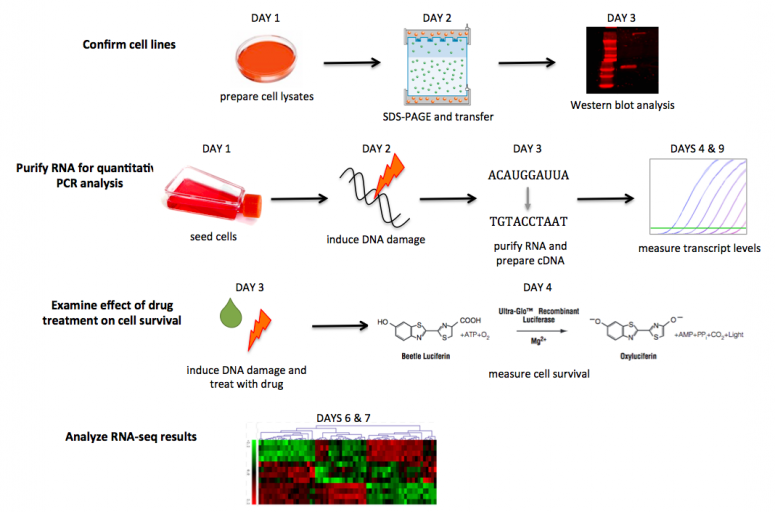20.109(S17):Module 2
Contents
Module 2
Lecturers: Leona Samson and Ernest Fraenkel
Instructors: Noreen Lyell, Leslie McClain and Maxine Jonas
TA: Rob Wilson
Lab manager: Hsinhwa Lee
Overview
Non-homologous end joining (NHEJ) is a pathway of DNA repair by which double-strand breaks are ligated together. In specific types of cancer, targeting NHEJ is an effective treatment option as a paradox exists in cancer. Whole genome sequencing has revealed that the cells of many tumor types have mutations in genes necessary for DNA repair. These mutations are responsible for cells becoming cancerous, but are also detrimental because, just like normal cells, cancer cells must divide to survive. Thus, a cancer cell will develop an ‘addiction’ to a DNA repair pathway – specifically, a pathway different from the one with the mutation that caused the cell to generate a tumor. Recent cancer therapies seek to exploit this addiction by targeting the intact pathway used by the tumor cells to repair DNA damage due to intrinsic breaks that occur during replication. In addition, the effectiveness of DNA damage induced by chemotherapy treatment may be enhanced by also disrupting the functional repair pathways of tumor cells.
In this module, you will examine the effect of DNA damage on cells that are deficient in homologous recombination, a DNA repair pathway that uses sequence homology to correct double-strand breaks. To this end, you will address several research questions:
- Does drug treatment affect cell survival following DNA damage?
- What genes are differentially expressed in response to inducing DNA damage?
An additional goal of Module 2 is for you to synthesize data from different experiments into a single story. More often that not, researchers reach conclusions using results gathered from more than one experimental approach. Multiple layers of support can bolster a conclusion as they eliminate biases that may exist in a particular method of analysis. Furthermore, for complex questions it may be necessary to include data from several approaches to provide a sufficient conclusion.
Lab links: day by day
M2D1: Confirm cell lines and practice tissue culture techniques
M2D2: Prepare Western blot and induce DNA damage for quantitative PCR assay
M2D3: Purify RNA for quantitative PCR assay and treat cells for survival assay
M2D4: Complete cell survival assay and examine transcript levels in response to DNA damage
M2D5: Journal club I
M2D6: Practice data analysis methods
M2D7: Analyze RNA-seq data
M2D8: Journal club II
M2D9: Examine quantitative PCR results
Data
See all M2 student data on the Discussion page.
Assignments
Journal club presentation
Research article
References
- A syngeneic variance library for functional annotation of human variation: application to BRCA2. Cancer Research. 68:5023-5030.
- Synthetic lethality: exploiting the addiction of cancer to DNA repair. Blood Journal. 117:6074-6082.
- Coming of age: ten years of next generation sequencing technologies. Nature Reviews: Genetics. 17(6):333-51.
- Microarrays, deep sequencing and the true measure of the transcriptome. BMC Biol. 9:34
- Illumina Sequencing Technology. Illumina.

